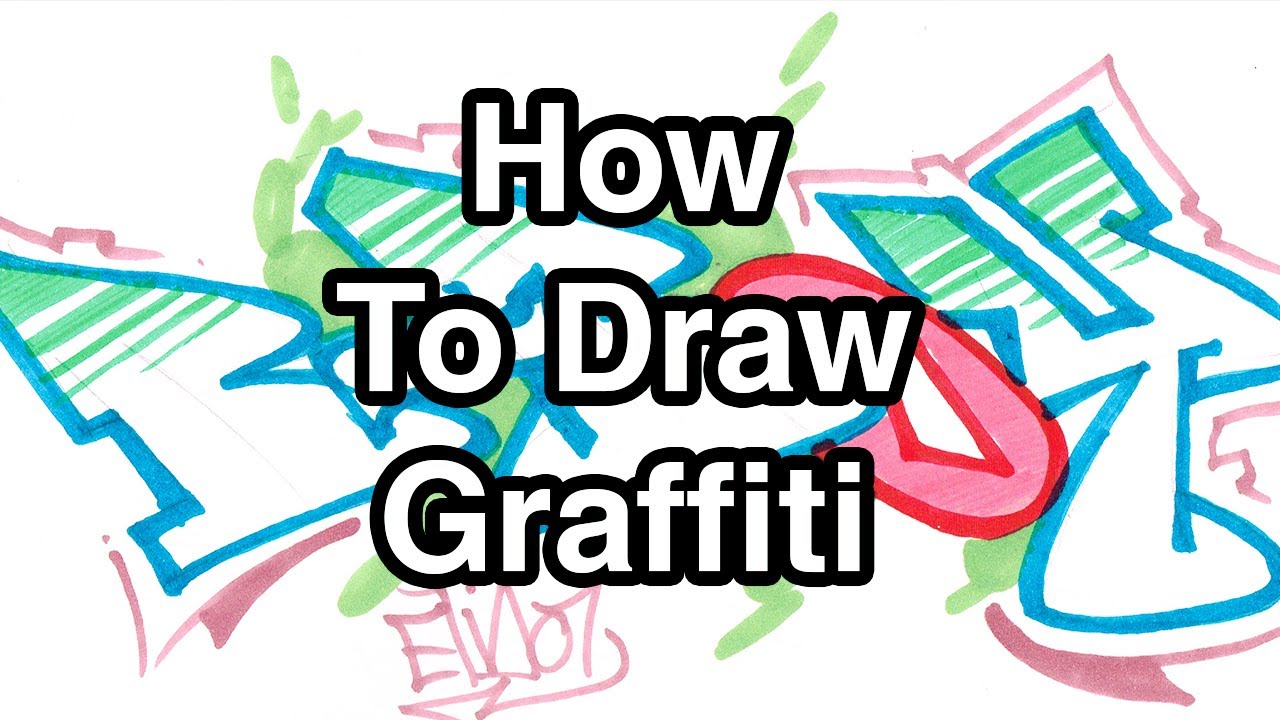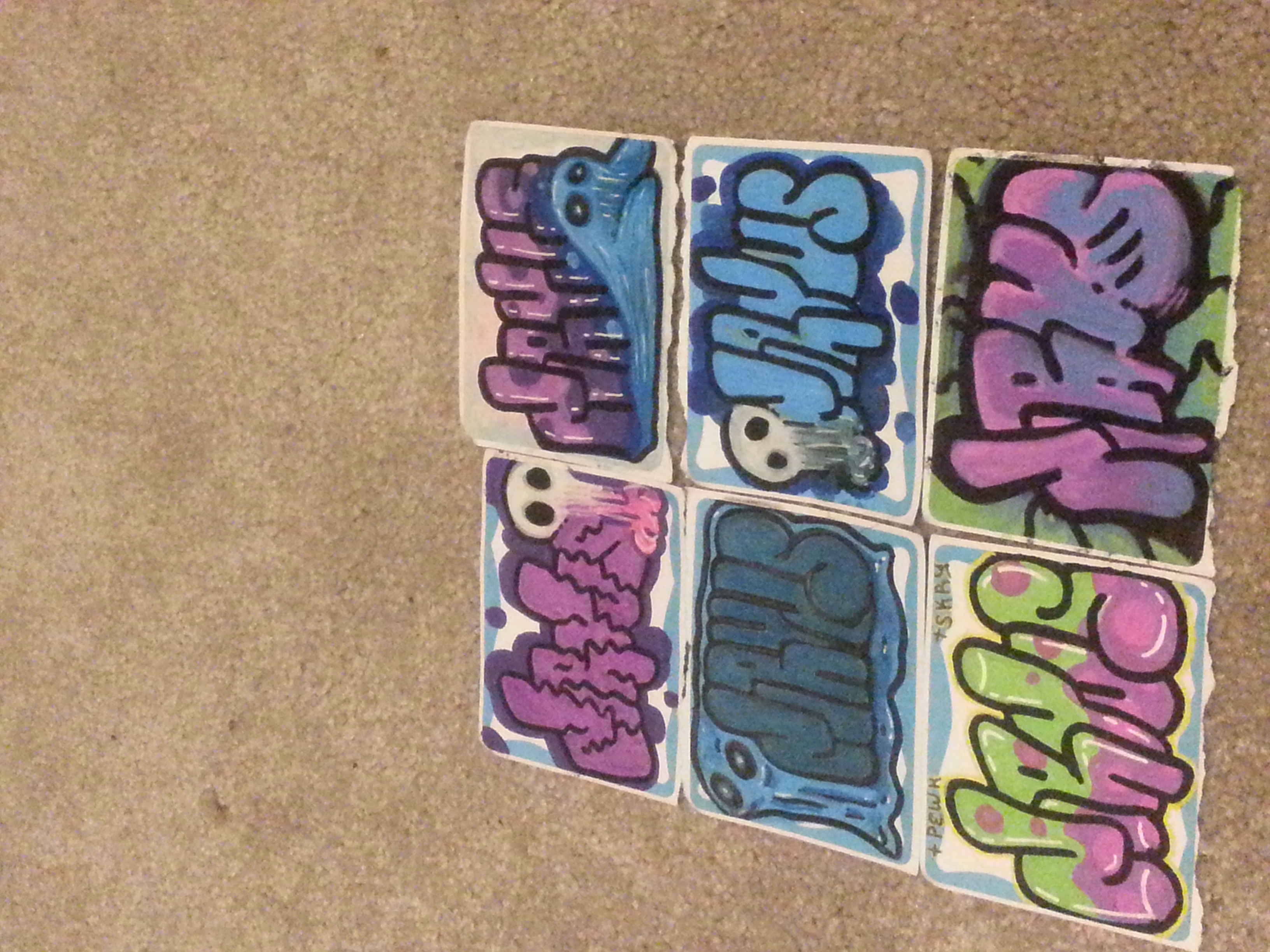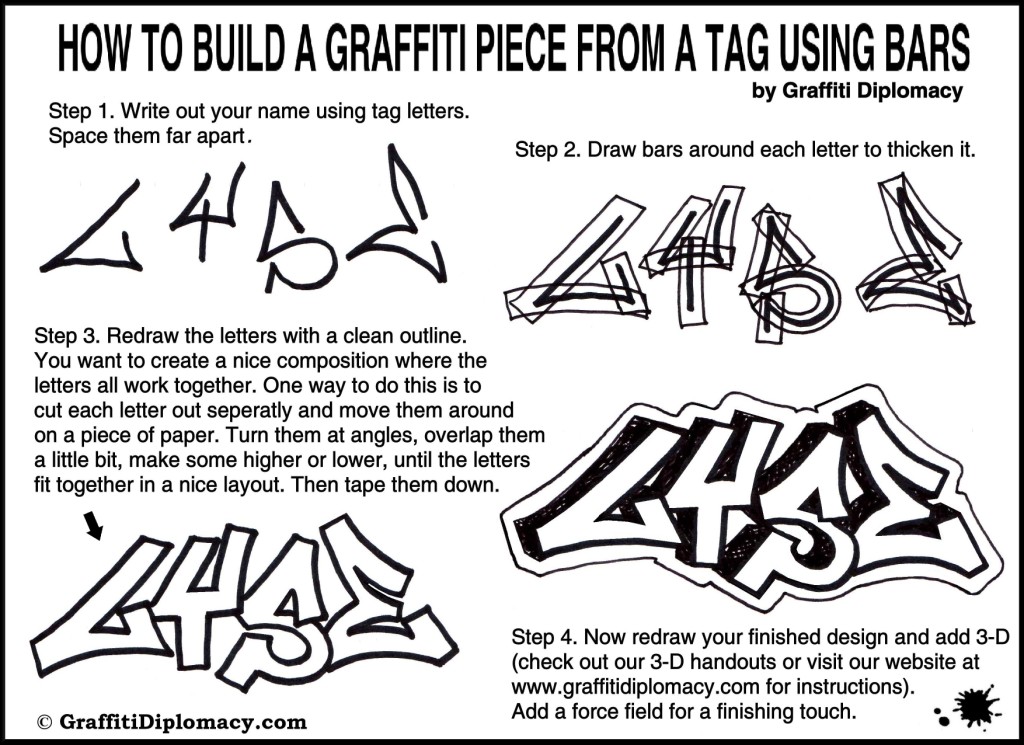How to Draw Graffiti Style Art
In this article, you will learn how to draw graffiti letters for beginners, in 7 basic but important steps.
When I started painting graffiti fifteen years ago, I struggled to find any kind of information on how to draw graffiti letters for beginners and therefore, develop my skills in such a secretive art form. The only way to learn was making (lots of) mistakes and meeting other graffiti writers , which can be a very slow process. It usually takes an individual several years to be able to draw or paint to a standard that, other graffiti writers would admire.
Graffiti experience can take a lot of perseverance, but it is well worth it.
Luckily for you, this article will help you skip the hard learning curve and avoid the mistakes most people make when they start out. By the time you've finished reading and understanding how to draw graffiti letters for beginners, we'll have covered all the basic drawing skills you need, then with practice you can go on to develop your own style.
Our Recommended for Beginners: Learn to Tag

RECOMMENDED ARTICLE: World's Top 20 Most Famous Graffiti Artists.
So, lets start with the learning.
1. Graffiti History:
Before putting pencil to paper, the best way to gain a good understanding on how to draw graffiti letters for beginners is to know a little bit about its history. The more you know about the early days of graffiti and its origins the bigger the advantage you have when it comes to style and skill (check out our graffiti timeline info-graphic) .
The most credible writers today all have elements of early style in their work, so know your history.

With a bit of research, you'll learn the graffiti art movement is a sub-culture with its own lifestyle, jargon and values. It's worth acknowledging modern graffiti culture; it is very different to how it was when it began in the 1970s and 80s.
It's not as fashionable to walk around finger-clicking in your custom all-denim outfit today.
2. Inspiration:
For further inspiration, it's a really good idea to seek out art on the walls of your local area and take some photos. In most cities and large towns, there are legal walls (click here if you want to find legal wall in your local area) where artists can paint with permission.
Usually, you'll find a high standard of graffiti here because artists can spend many hours there without fear of being arrested. There is normally a pretty high turnover of paintings as people paint on top of previous work while learning how to draw graffiti letters for beginners.
If you look around your own city you'll see recurring themes in different artists style. I personally think it's good for writers to maintain these trends as it gives each city it's own unique contribution to the movement.
If you do graffiti with a group of friends, a.k.a a crew you might find that you all develop similar styles.
Don't copy another artists style directly, this is known as biting and makes you look uncreative and a bit of a fraud. Most people will do this to some degree when starting, maybe even unintentionally, (whether they'll admit it or not) but don't claim someone else's style as your own.
What differentiates an innovative artist from a mediocre one is their ability to develop ideas for their letters outside graffiti; from illustration, comics, art and the world around them. You can get inspiration from anywhere.
3. Letter form and drawing the outlines, start the action:
Okay, so now it's time for the action. In this lesson we will cover how to develop letter form and draw the outlines of you're letters, so you will need some tools:
- plain paper
- a pencil
- an eraser
- a sharpener
- and very importantly, a fine line black marker or pen (check here the ultimate guides for graffiti markers for beginners).
The foundation of graffiti is typography. Typography is the basic art of letters, even the font your reading right now was originally drawn and designed by someone. Graffiti writers have a good understanding of typography and often go on to successful careers in graphic design and other creative fields.
The purple bits are serif

Have a look at the bar structure of the letters:

Source: graffitidiplomacy.com
The letters are made up of bars, some straight and some curved, all of equal thickness and with even gaps between them.
Practice drawing some of the letters from the sans-serif alphabet, concentrate on the equal thickness of the bars, the angles, symmetry and the spacing of the gaps in the letters.
When you start drawing graffiti use bars to build your letters. After time you'll have a good idea of your own style and letter structure and you wont need to keep this up (which means being able to paint much quicker).
4. Writing tags, like doing a dance:
So now you have a basic understanding of letter structure, its time to share with you the most important secret to style.
An artist once, described this perfectly by saying how writing a tag , the simplest form of graffiti, is like doing a dance. Often when people start their style looks really deliberate and forced.
The reason graffiti appeals to the human eye is because the letters have energy and movement that resemble life and this evokes emotion in the viewer.
This is why the use of arrows is common in graffiti; they are a symbol of direction. So it figures that if the symbols we call letters could really move, they would have arrows to indicate their direction.
The movement in your letters also comes from the way they're painted. Unlike many other methods of drawing or painting when you do graffiti, you use your whole body. When you sketch your outline on the wall with spray paint, you stretch and sweep your arms, you lean, you bend your knees. Also, due to it's inherently illegal nature, graffiti has traditionally been painted at speed, and this is why the lines and strokes in graffiti look so dynamic and fluid.
Remember when drawing, your letters have to give the impression of movement and life.
Here is an example of how a simple letter can evolve to have more character.

If you look at the second image in from the left you can see how just by giving the vertical bars of the letter a natural looking curve it instantly gives it a bit more energy and personality.
5. Pick your Graffiti name, be creative:
Continuing on how to draw graffiti letters for beginners, pick your graffiti name, or tag.
Some writers change their name over time as they get better or bored of the letters, others stick with the same name throughout their graffiti career.
Lots of beginners go for names like 'FLAMER', 'ACE' or 'LAZERCAT', which have all the attitude of a temporary tattoo.
You can pick a word that's unique or personal to you, but remember it's supposed to be a super secret alias so try and avoid writing your own name. A lot of writers pick a random name just because they like the way the letters go together.
Harder letters to place in your word tend to be bottom-heavy e.g. L or J, or top-heavy e.g. T, P, F or Y or just plain skinny e.g. I. Letters that are evenly balanced or square are the easiest to fit e.g. M, S, N, B, E, Z.
Think about the length of your name, most graffiti writers will have four to five letters. If your words too short your not giving yourself much to work with, too long and you could be there all night.
Avoid using the same letter twice in a name, especially next to itself. If you draw that letter exactly the same both times your piece will look boring, if you draw the letter differently the second time it could make your style look inconsistent.
Once you've picked your name do some research to make sure there's no one famous or prolific writing the same thing, this will save you some embarrassment.
Write your chosen name down in capitals on a bit of paper and see how it looks.
6. Over-lapping and Under-lapping Letters:
Follow this step-by-step example as you draw your own word

Notice how begun over-lapping the letters, normally the first letter over-laps the second, then the second over-laps the third and so on, this makes the word easy to read. You can have different parts of the letters under-lapping or over-lapping each other, the choice is yours.
Only over-lap the letters slightly; you don't want to block out crucial parts of them.
I shortened the bottom bar of the L so the letter can be brought a little bit closer to the E. To make the word have more flow it's a good idea to minimize large gaps between the letters. At the moment there is a huge gap between the tops of the L, the E, the A and the R, but we'll fix that in a bit.
As we go through these steps try out the different techniques with your letters, see which ones work and which don't. Drawing letters is all about experimenting so sketch lightly and make sure you have an eraser ready to take out the bits you don't like and need to replace.

Now we need to add some curves to the letters to make them look more natural and start giving them a bit of life. Let's look at the letters one by one.
- L The vertical bar has now got a curve in it and looks like it's arching its back and pushing its chest out, this has also helped close the gap at the top next to the E. Where the bottom bar of the L over-laps the E it still looks a bit awkward, because it's blocking out the join of the bottom horizontal bar of the E with it's vertical bar.
- E The top horizontal bar now curves down and I've added a serif to the end of it, which helps minimize the gap between the E and A
- A Like in the earlier example the vertical bars are now curved and the letter looks like it's swinging to the right.
- R Instead of the right leg just pointing straight down it's now got a curve in it, which kind of makes it look like it's just kicked something.
- N The left bar is now arched away from the R, and the centre connecting bar curves down. The right bar has been brought in closer at the top to close the gap between the center bar.

This is where we start seeing how to solve the problems of awkward over-laps by seeing what letters can connect and what will work. You don't have to make your letters join together, and often having all the letters join up can look a little weird.
- L & E Something needed to be done with the bottom of the L so I erased the bit that was bugging me and experimented to come up with a solution. The L's bottom bar is now extended and has a kink a bit like a knee joint and there is now a serif on the end of it, this can now double-up and act as the bottom part of the E. Both letters are still legible and it looks a bit more interesting.
- A Look how the horizontal cross-bar is now poking out a bit on the right, and the right bar of the A is now connected to the R with an over-lapping join. I could have had the R over-lapping the A but personally I think it looks better this way round.
- R The top arch is pinched and brought in a bit, this makes the hole in the center of the R smaller, you'll see writers use this method quite a lot with their Rs, Ps and Bs.
- N The bottom of the left bar now joins up with the kicker of the R with a little horizontal mini bar and the top of the right bar has been turned in on the rest of the letter to make a right angle and close that gap up a bit more.
Now we're going to add some common style elements to give the piece a little bit of a wild style look and close up some of those remaining gaps.
- L There is now a wavey arrow coming off the top and pointing towards the bottom of the letter, this snaking shape gives more movement and changes the balance of the letter. There's a horizontal line going through the arrow's bar, which looks like the shape has been cut by something and this added detail breaks things up a bit more. I've extended the vertical bar of the L so that it goes past the join to the bottom bar, giving the letter a sturdier base, like it's sitting down. The top of the L is now curved slightly to contrast with the rigid right angles all through the piece. The serif on the end of the L's bottom bar has got more curves and angles in it giving it a bit more personality.
- E Not much has changed here, a small serif has been added on the top left corner, just to close up that gap with the L a little bit more. The middle bar is now a huge arrow pointing towards the A.
- A I've added a heart serif to the bottom of the left bar, these were used lots in the early days and people add them to their pieces to give it that old-school look. There is now a serif curving out at the top of the A. The bottom right bar has been disconnected next to where it joins the cross bar so you can see what's going on with the R underneath.
- R There's a wavy serif flying off the top to close up that gap next to the A and the hole on the inside has been replaced by a star, the left side of the star is flat to keep the shape of the left bar, this is another element you'll see in a lot of old-school pieces.
- N The handle on the left bar underneath the R closes up that gap, and I've added another cut bar like the one on the arrow from the L. The semi-circle added at the bottom of the letter looks like it's broken off from the energy of the piece.

Finally go over your final outline with a pen and erase all the guide lines you've used to make up your bars.
You can then work on different areas of drawing graffiti, like adding shadows or 3Ds, highlights and color. Now you know how to draw graffiti letters for beginners. Practice makes masters. Once you've got good at the basics, move on.Break the rules you've learned, start trying different things and develop your own style.
Our Recommended for Beginners: Learn to Tag

If you've got any questions or would like to know something that I didn't cover leave a comment below!
DISCLAIMER: PAINTING ON PROPERTY THAT DOESN'T BELONG TO YOU WITHOUT PERMISSION IS ILLEGAL. WE ARE NOT SHOWING HOW TO DRAW GRAFFITI LETTERS FOR BEGINNERS TO GET YOU IN TROUBLE. NEED SOME REASONS WHY YOU SHOULDN'T DO GRAFFITI? CLICK HERE
Below are some examples of different artists styles from all over the world:





I hope you've found this guide useful, and if you have please share it!
How to Draw Graffiti Style Art
Source: https://graffitiknowhow.com/how-to-draw-graffiti-letters-for-beginners/
0 Response to "How to Draw Graffiti Style Art"
Enviar um comentário